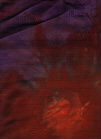

 In tie-dyeing, a garment dyed with purple and orange will be muddy in an
unattractive way, unless the two colors are separated with a band of fuchsia.
In low water immersion dyeing, however, even otherwise clashing colors may mix
in harmonious and beautiful ways. Using purple and orange together is a real test of
the idea. I think it was successful.
This rayon caftan was dyed by the low
water immersion method, using sodium
carbonate to fix the dyes just as with cotton. Rayon tends
to prefer a slightly higher pH than cotton, but not enough
so that you would need to alter your usual recipe, and it tends
to dye much more brightly than unmercerized cotton. However,
Rayon fibers are notably weak when wet, unlike those of
the closely relate cellulose fiber lyocell (brand name: Tencel), so
you must be careful to wash on delicate cycle only, and
avoid hot-water washes, though those are best at ridding a
garment of unwanted extra dye.
The detail shows a moire effect in the close-up, implying a
texture such as that of corduroy. The rayon is actually
quite smooth, and the moire effect an artifact of
the scanning process.
In tie-dyeing, a garment dyed with purple and orange will be muddy in an
unattractive way, unless the two colors are separated with a band of fuchsia.
In low water immersion dyeing, however, even otherwise clashing colors may mix
in harmonious and beautiful ways. Using purple and orange together is a real test of
the idea. I think it was successful.
This rayon caftan was dyed by the low
water immersion method, using sodium
carbonate to fix the dyes just as with cotton. Rayon tends
to prefer a slightly higher pH than cotton, but not enough
so that you would need to alter your usual recipe, and it tends
to dye much more brightly than unmercerized cotton. However,
Rayon fibers are notably weak when wet, unlike those of
the closely relate cellulose fiber lyocell (brand name: Tencel), so
you must be careful to wash on delicate cycle only, and
avoid hot-water washes, though those are best at ridding a
garment of unwanted extra dye.
The detail shows a moire effect in the close-up, implying a
texture such as that of corduroy. The rayon is actually
quite smooth, and the moire effect an artifact of
the scanning process.
Page created: August 14, 1999.
Last updated: Saturday, February 22, 2003;
Downloaded at: Tuesday, December 16, 2025, 07:35PM EST